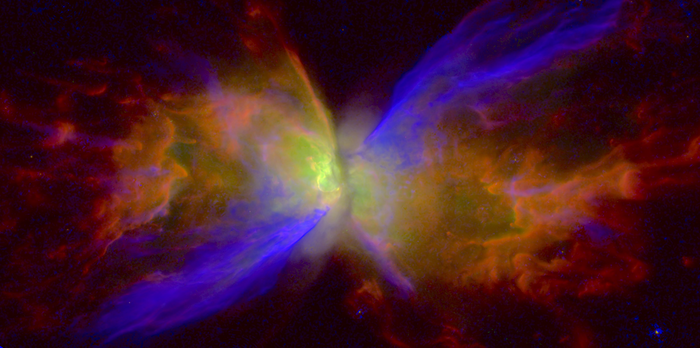Planetary nebulae form when red giant stars expel their outermost layers as they run out of helium fuel — becoming hot, dense white dwarf stars that are roughly the size of Earth. The material that was shed, enriched in carbon, forms dazzling patterns as it is blown gently into the interstellar medium.

Credit: Bruce Balick/University of Washington/Joel Kastner/Paula Baez Moraga/Rochester Institute of Technology/Space Telescope Science Institute
Planetary nebulae form when red giant stars expel their outermost layers as they run out of helium fuel — becoming hot, dense white dwarf stars that are roughly the size of Earth. The material that was shed, enriched in carbon, forms dazzling patterns as it is blown gently into the interstellar medium.
Most planetary nebulae are roughly circular, but a few have an hourglass or wing-like shape, like the aptly named “Butterfly Nebula.” These shapes are likely formed by the gravitational tug of a second star orbiting the nebula’s “parent” star, causing the material to expand into a pair of nebular lobes, or “wings.” Like an expanding balloon, the wings grow over time without changing their original shape.
Yet new research shows that something is amiss in the Butterfly Nebula. When a team led by astronomers at the University of Washington compared two exposures of the Butterfly Nebula taken by the Hubble Space Telescope in 2009 and 2020, they saw dramatic changes in the material within the wings. As they will report on Jan. 12 at the 241st meeting of the American Astronomical Society in Seattle, powerful winds are driving complex alterations of material within the nebula’s wings. They want to understand how such activity is possible from what should be a “sputtering, largely moribund star with no remaining fuel.”
“The Butterfly Nebula is extreme for the mass, speed and complexity of its ejections from its central star, whose temperature is more than 200 times hotter than the sun yet is just slightly larger than the Earth,” said team leader Bruce Balick, a UW professor emeritus of astronomy. “I’ve been comparing Hubble images for years and I’ve never seen anything quite like it.”
The team compared high-quality Hubble images taken 11 years apart to chart the speeds and growth patterns of features within the nebula’s wings. The bulk of the analysis was performed by Lars Borchert, a graduate student at Aarhus University in Denmark who participated in this study as a UW undergraduate student.
Borchert discovered roughly half a dozen “jets” — beginning about 2,300 years ago and ending 900 years ago — pushing material out in a series of asymmetrical outflows. Material in the outer portions of the nebula is moving rapidly, at about 500 miles per second, while material closer to the hidden central star is expanding much more slowly, at about a tenth of that speed. Paths of the jets cross one another, forming “messy” structures and growth patterns within the wings.
The nebula’s multi-polar and swiftly changing interior structure is not easy to explain using existing models of how planetary nebulae form and evolve, according to Balick. The star at the center of the nebula, which is hidden by dust and debris, could have merged with a companion star or drew off material from a nearby star, creating complex magnetic fields and generating the jets.
“At this point, these are all just hypotheses,” said Balick. “What this shows us is that we don’t fully understand the full range of shaping processes at work when planetary nebulae form. The next step is to image the nebular center using the James Webb Space Telescope, since infrared light from the star can penetrate through the dust.”
Stars like our sun will swell into a red giant and form planetary nebulae someday, expelling carbon and other relatively heavy elements into the interstellar medium to form star systems and planets in the far future. This new research, and other “time-lapse” analyses of planetary nebulae, can help illustrate not just how the materials for the star systems of tomorrow will take shape, but also how the building blocks of our own oasis were produced and gathered billions of years ago.
“It’s a creation story that is happening over and over again in our universe,” said Balick. “The shaping processes provide key insight into the history and impacts of the stellar activity.”
Other team members are Joel Kastner of the Rochester Institute of Technology and Adam Frank of the University of Rochester.
###
For more information, contact Balick at [email protected].
Corresponding events at the 241st meeting of the American Astronomical Society in Seattle:
- Thursday, Jan. 12, 2023 (10:15 a.m. U.S. Pacific Time): AAS press conference
- Topic: “Clouds and Nebulae”
- Thursday, Jan. 12, 2023 (1 p.m. U.S. Pacific Time): iPoster session
- Abstract title: “The Tempestuous Life of the Butterfly Nebula, NGC 6302”
- Authors: Balick B, Borchert L, Kastner J, Frank A
- Program number: 468.05
- Session: “Planetary Nebulae, Supernova Remnants” (1 p.m. to 2 p.m.)
Link to Google Drive folder containing image files with caption/credit information:
https://drive.google.com/drive/folders/1Z1Skii4CrEr7yVvjg9fm7FeZTqABebeZ?usp=sharing
Method of Research
Observational study
Subject of Research
Not applicable




